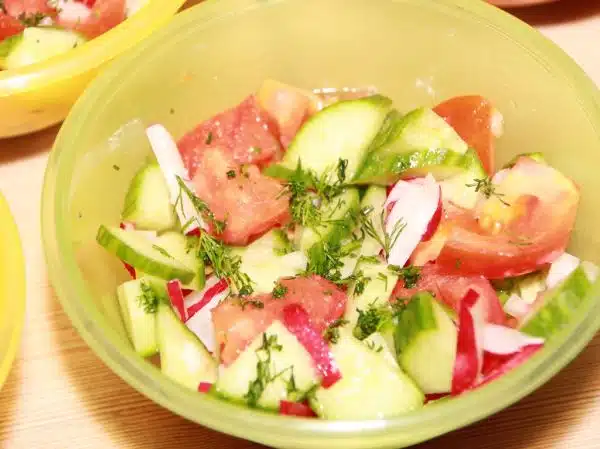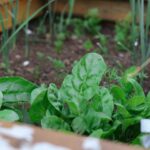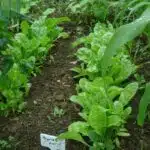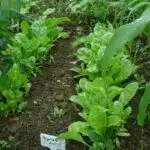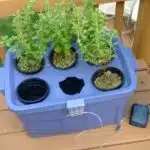Gardening can be a therapeutic and fulfilling activity that provides a sense of accomplishment and connection to nature. However, not all gardeners have access to full sun exposure for their plants. Those who live in areas with limited sunlight or have gardens shaded by trees or buildings may feel discouraged about the possibility of growing vegetables. Fortunately, there are numerous vegetable varieties that thrive in partial shade conditions, making it possible for anyone to enjoy fresh produce from their own garden.
In this article, we will explore 16 vegetables that can grow in partial shade, providing options for those with limited sunlight access. From leafy greens like spinach and lettuce to root vegetables like carrots and beets, these plants are not only easy to grow but also offer a range of culinary possibilities. Moreover, growing your own vegetables is an excellent way to reduce your carbon footprint and contribute towards sustainable living while promoting self-sufficiency and healthy eating habits.
Understanding Partial Shade Gardening
Partial shade gardening is a great option for those who have limited space or live in areas with less sunlight. Understanding the nuances of this type of gardening can help maximize yields and ensure that your plants thrive. When choosing the right location for your partial shade garden, it’s important to consider the amount of sunlight your plants will receive. While partial shade means less direct sunlight than full sun, it still requires at least 3-6 hours of direct sunlight per day.
One way to maximize yields in a partial shade garden is by selecting vegetables that are well-suited for this type of environment. Leafy greens such as lettuce, spinach, and kale are great options as they require less direct sunlight than other vegetables. Additionally, these plants can be grown closer together which allows for more efficient use of space in a small garden. It’s also important to note that some vegetables may require more or less light depending on their specific variety, so be sure to do your research before planting.
Choosing the right location for your garden is crucial to its success. Partial shade gardens should ideally be located near trees or buildings that provide some natural shade throughout the day. Avoid areas with dense tree cover as this could block too much sunlight from reaching your plants. With careful planning and appropriate plant selection, you’ll be able to create a thriving partial shade garden that produces an abundance of fresh produce throughout the growing season.
Transitioning into the subsequent section about leafy greens for partial shade: In order to make the most out of your partial shade garden, it’s important to choose vegetables that are suited for this type of environment. Leafy greens are an excellent choice as they not only tolerate lower levels of light but also provide a range of nutritional benefits when consumed regularly.
Leafy Greens For Partial Shade
Understanding partial shade gardening is crucial for any gardener, as it helps to maximize the potential of your garden. Partial shade gardening involves growing plants that can thrive in areas with limited sunlight. One of the benefits of partial shade gardening is that it allows you to grow a variety of vegetables, including those that may not typically do well in full sun.
If you’re interested in growing vegetables in partial shade, container gardening is an excellent option. Container gardening allows you to move your plants around to find the best location for them, and it also allows for better control over soil quality and moisture levels. Additionally, companion planting can be used to maximize space and enhance plant growth. For example, planting lettuce underneath taller plants such as tomatoes or peppers can help protect them from the harsh midday sun.
One leafy green that does particularly well in partial shade is spinach. Spinach is a cool-weather crop that prefers temperatures between 50-60°F and will bolt (go to seed) quickly in hot weather. Planting spinach in an area with filtered sunlight or dappled shade will help keep the soil cooler and prevent bolting. Additionally, spinach can be grown in containers, making it an ideal choice for partial shade gardens with limited space.
Transition: While spinach is a great option for leafy greens in partial shade gardens, there are several other varieties worth considering as well.
Spinach
Spinach is a versatile and nutritious vegetable that can be easily grown in partial shade. It is a cool-weather crop that prefers well-drained soil with a pH of 6.0 to 7.0, and requires moderate watering to thrive. Spinach can be sown directly into the ground or started indoors and transplanted outside once the seedlings have developed at least two true leaves.
Growing techniques for spinach vary depending on the season and climate. In cooler temperatures, spinach grows best when planted in rows spaced approximately 12 inches apart, with each seed sown roughly one inch deep. As temperatures rise, spinach should be planted in areas that receive partial shade to avoid wilting from excessive heat exposure. To maintain healthy growth, it is essential to keep the soil moist but not waterlogged.
Spinach is a nutrient-rich vegetable that provides numerous health benefits to those who consume it regularly. It is an excellent source of iron, which supports healthy blood circulation, and contains vitamins A and C, which boost the immune system and promote healthy vision. Additionally, spinach contains antioxidants that protect against cellular damage from free radicals, reducing the risk of chronic diseases such as cancer and heart disease.
Moving onto lettuce cultivation techniques, there are several varieties of lettuce that grow well in partial shade and offer similar nutritional benefits to spinach. Like spinach, lettuce prefers cool temperatures and well-drained soil but requires more frequent watering than spinach due to its shallow root system. Lettuce can be grown directly in the ground or in containers, making it a great choice for small-space gardening projects.
Lettuce
Spinach is an excellent vegetable to grow in partial shade. Its leaves are tender, delicious, and rich in vitamins and minerals. However, if you’re looking to diversify your garden, lettuce is another great option.
Lettuce is a cool-season crop that thrives in temperatures between 45-75 degrees Fahrenheit. It’s easy to grow and can be harvested within weeks of planting. Lettuce also comes in a variety of shapes, colors, and textures, making it a beautiful addition to any garden.
Container gardening is an excellent way to grow lettuce in partial shade. You can use pots or raised beds filled with well-draining soil and compost. If you want to maximize your space, consider companion planting lettuce with other vegetables like radishes or carrots. These plants help each other by repelling pests or attracting beneficial insects that pollinate flowers and control harmful bugs.
Swiss chard is another vegetable that grows well in partial shade. Its colorful stems and large leaves make it an attractive addition to any garden bed or container. Swiss chard can also be used as a substitute for spinach in recipes like quiches or sautéed dishes. With proper care and attention, you can enjoy a bountiful harvest of fresh vegetables all season long.
Swiss Chard
Swiss chard is a versatile vegetable that can be grown in partial shade. It is a member of the beet family and has large, dark green leaves with red, white or yellow stalks. Swiss chard is an excellent source of vitamins A, C and K as well as magnesium, potassium and iron.
Growing techniques for Swiss chard are relatively simple. It prefers well-drained soil with plenty of organic matter. If you want to grow it from seeds, sow them 2-3 inches apart and ½ inch deep in rows spaced 12-18 inches apart. Once they germinate, thin them out by leaving only one plant every 6-8 inches. Alternatively, you can buy seedlings or start your own indoors before transplanting them outside.
Varietal selection is important when growing Swiss chard. Some popular varieties include ‘Bright Lights’ which has rainbow-colored stalks and ‘Fordhook Giant’ which has dark green leaves and thick white stalks. Other varieties to consider are ‘Ruby Red’, ‘Rainbow’, and ‘Green Lucullus’. With the right growing techniques and varietal selection, anyone can enjoy Swiss chard fresh from their garden.
Moving on to kale, another leafy green that thrives in partial shade…
Kale
Kale is an easy to grow vegetable that prefers a cooler climate and partial shade. This leafy green is one of the most popular vegetables for home gardens, as it can be harvested throughout the year. Gardeners can choose from a variety of kale varieties, including curly kale, dinosaur kale, and red Russian kale. When selecting a variety of kale, gardeners should consider factors such as climate, soil type, and the desired taste and texture of the kale.
Growing Kale
Kale, a member of the brassica family, is one of the most versatile vegetables to grow in partial shade. Growing kale requires proper techniques and care to ensure a bountiful harvest. For beginners, it is essential to choose a variety that is tolerant to shade and has fewer requirements for sunlight. Additionally, planting kale during cooler seasons can help reduce the risk of bolting.
Kale has a high nutritional value and is an excellent addition to any diet. It contains vitamins A, C, K, and minerals such as calcium, potassium, and iron. Growing kale in partial shade can enhance its nutritional benefits by reducing its bitterness levels. Kale that grows in shaded areas tends to be more tender and have a sweeter taste than those grown in full sun.
To maximize the growth of kale in partial shade, ensure it receives at least four hours of direct sunlight each day. Adequate water supply is necessary for lush green leaves and healthy plants; however, avoid overwatering as it may lead to fungal infections or root rot. Finally, regular fertilization with nitrogen-rich organic matter such as compost or manure can boost plant growth and ensure adequate nutrient supply for optimal yields.
Varieties Of Kale
Exploring different varieties of kale is essential for any gardener looking to grow this nutritious vegetable. The variety of kale you choose depends on several factors, including your location, climate, and personal preferences. Some popular varieties of kale include curly kale, Tuscan kale or Lacinato, Siberian Kale and Red Russian Kale. Each variety has its unique flavor profile and texture, making them suitable for various cooking styles.
When selecting a variety, it is essential to consider its growing requirements to ensure optimal yields. For instance, some types of kale are more tolerant to shade than others; therefore, they may be suitable for gardeners with limited space or partial shade areas. Additionally, some varieties may require more sunlight and warmth than others to thrive.
Growing tips for optimal yield also depend on the type of kale you choose. For instance, curly kale requires regular pruning to promote bushy growth and prevent bolting. On the other hand, Tuscan kale is more resilient and can tolerate harsher weather conditions. Providing adequate sunlight exposure and proper irrigation techniques is crucial in ensuring healthy plant growth regardless of the variety you choose.
In conclusion, exploring different varieties of kale can be rewarding as it offers unique tastes and textures that add value to any meal plan. When selecting a variety to grow in your garden, consider its growing requirements and adapt your cultivation techniques accordingly. With proper care and attention to detail in planting methods such as spacing plants appropriately or providing adequate nutrient supply through composting practices can result in lush green leaves full of nutrients that will help serve those around you with delicious meals!
Arugula
Arugula is a leafy green vegetable that has a strong and peppery taste. It is easy to grow and can be cultivated in partial shade. Growing arugula requires the right amount of sunlight, which can be achieved by planting it in areas where it can receive at least 4-6 hours of direct sunlight per day. However, it can also thrive in areas with only partial shade.
To plant arugula successfully, one must prepare the soil properly by adding organic matter such as compost or aged manure. The soil should be well-draining and have a pH level between 6.0 and 7.0. Arugula seeds should be planted about 1/4 inch deep and spaced approximately 1 inch apart. Water regularly to keep the soil moist but not waterlogged.
Culinary uses for arugula include using it fresh in salads or as a topping on pizza, blending it into pesto, or sautéing it with garlic and olive oil as a side dish. Its versatility makes it an excellent addition to any kitchen garden. With proper growing techniques, you can enjoy fresh, flavorful arugula throughout the growing season.
Moving forward to root vegetables for partial shade, there are several options available that thrive in these conditions. These vegetables are perfect for gardeners who want to maximize their space while still enjoying homegrown produce.
Root Vegetables For Partial Shade
Root vegetables, such as carrots, beets, and radishes, can be grown in partial shade. Carrots require a soil pH between 6.0 and 6.8 for optimal growth, and should be sown in early spring. Beets should be planted in either spring or fall, and benefit from loose, well-drained soil with a neutral pH. Radishes are fast-growing and require full sun but can also tolerate partial shade. Carrots, beets, and radishes should all be planted at least two inches apart and watered regularly. With the right conditions, these root vegetables can be harvested in as little as four to six weeks.
Carrots
Carrots are one of the most popular root vegetables due to their versatility and nutritional value. Growing carrots in partial shade is a bit more challenging than growing them in full sun, but it is still possible with the right techniques. The key to successfully growing carrots in partial shade is choosing the right variety and providing adequate soil moisture.
One way to increase the chances of success when growing carrots in partial shade is by companion planting. Planting radishes or lettuce alongside carrots can help attract beneficial insects and improve soil health. Additionally, these plants can provide some shading for the carrot seedlings during hot summer days, which can help prevent them from drying out.
Container gardening is another option for those who want to grow carrots in partial shade. Containers allow you to control the amount of sunlight your plants receive by moving them around as needed. Just make sure to choose a container that provides enough depth for carrot roots to grow properly. With proper care and attention, even those who only have access to partial shade can enjoy a bountiful harvest of delicious home-grown carrots.
Beets
Root vegetables are a popular choice for gardeners who want to grow their own produce. However, growing root vegetables in partial shade can be a bit of a challenge. In this regard, choosing the right variety and implementing proper growing techniques can help ensure success. Companion planting is also an effective technique that can benefit the growth of root vegetables.
One such root vegetable that can thrive in partial shade is beets. Beets have a sweet and earthy flavor that makes them a favorite among many gardeners. They are also quite versatile when it comes to cooking, making them an excellent addition to any kitchen. When growing beets in partial shade, it is important to choose a variety that is suited for low light conditions.
Companion planting can greatly benefit the growth of beets as well. Planting lettuce or spinach alongside beets can help attract beneficial insects and improve soil health. Additionally, these plants can provide some shading for the beet seedlings during hot summer days, which can help prevent them from drying out. By implementing proper growing techniques and companion planting strategies, even those with partial shade gardens can enjoy a bountiful harvest of delicious home-grown beets.
Radishes
Radishes are another root vegetable that can be grown in partial shade. They have a crisp and spicy flavor, which makes them a great addition to salads and sandwiches. However, growing radishes in low light conditions requires choosing the right variety and implementing proper growing techniques.
When it comes to varieties suitable for partial shade, there are several options available. One such variety is the French Breakfast radish, which has a cylindrical shape and red-and-white skin. Another option is the Watermelon radish, which has a green-and-white exterior and a pink interior. Both of these varieties can tolerate some shade and have a quick maturity time, making them ideal for partial shade gardens.
To ensure success when growing radishes in partial shade, it’s important to implement proper growing techniques. This includes ensuring that the soil is well-drained and rich in organic matter, as well as providing adequate water and fertilizer. Additionally, planting them alongside other companion plants like lettuce or spinach can help improve soil health and attract beneficial insects that aid in pollination.
Overall, while growing root vegetables in partial shade can present some challenges, there are still plenty of options available for gardeners who want to cultivate their own produce. By selecting the best varieties suited for low light conditions and implementing proper growing techniques, even those with shady gardens can enjoy a bountiful harvest of delicious home-grown radishes.
Carrots
Root vegetables are a great option for partial shade gardens. These hardy plants can tolerate less sunlight and still produce a bountiful harvest. In the previous section, we discussed some popular root vegetables that thrive in partial shade, including turnips, radishes, and beets.
When it comes to growing root vegetables in partial shade, there are a few important techniques to keep in mind. First, make sure you select a spot with at least four hours of direct sunlight per day. While these plants can handle less light than other vegetables, they still need some sun exposure to thrive. Additionally, pay close attention to your soil requirements. Root vegetables prefer well-draining soil with plenty of organic matter.
Here is a table outlining the growing techniques and soil requirements for three popular root vegetables that do well in partial shade:
| Vegetable | Growing Techniques | Soil Requirements |
|---|---|---|
| Turnips | Thin seedlings to 3-4 inches apart once they have grown several leaves | Loose soil with good drainage; pH between 6.0-7.5 |
| Radishes | Sow seeds directly into the ground; thin seedlings as needed for spacing | Well-draining soil with high organic matter content |
| Beets | Plant seeds 1 inch apart and thin out as necessary once they have grown several leaves | Loamy soil with pH between 6.2-6.8 |
Incorporating these techniques will help ensure a successful harvest of delicious root vegetables from your partially shaded garden. Up next: beets! While often overlooked, beets are a versatile vegetable that can be enjoyed both raw and cooked in a variety of dishes. Let’s dive into how to grow them successfully in partial shade.
Beets
Beets are a versatile vegetable that can grow in partial shade. They are best planted in the early spring or late summer when temperatures are cooler. Beets prefer well-drained soil with a pH between 6.0 and 7.5. They require consistent watering to prevent the roots from becoming woody.
Growing techniques for beets involve planting them in rows, spacing them about two inches apart. As they grow, thin them out to allow each plant enough space to mature properly. Be careful not to damage the roots when thinning the plants. Beets can also benefit from a layer of organic mulch around their base, which helps retain moisture in the soil.
Beets can be used in many recipes, such as salads, soups, and even desserts. Roasting beets brings out their natural sweetness and is an easy way to prepare them for salads or side dishes. Boiling or steaming beets is another option that allows you to easily remove the skin for use in recipes like borscht or pickled beets. Regardless of how you choose to prepare your beets, they are sure to add color and flavor to any dish.
Moving on to radishes, these root vegetables are also great options for partial shade gardens. Like beets, they prefer cooler temperatures and consistent watering. Radishes have a short growing period and can be harvested as soon as three weeks after planting!
Radishes
- Radishes are an edible root vegetable, typically enjoyed raw and often used in salads.
- Radishes are easy to grow, and can withstand partial shade and cooler temperatures with ease.
- There are numerous varieties of radishes, with the most common being round, red varieties such as the Cherry Belle and French Breakfast.
- Radishes are an excellent source of vitamin C, with one cup of raw radishes containing 25% of the recommended daily intake.
- Varieties of radishes can also vary in flavor and texture, with some having a mild flavor and crunchy texture, while others are spicier and have a more pungent flavor.
- Radishes can be grown in nearly any type of soil, but they do require consistent watering in order to produce the best results.
Growing Radishes
Radish varieties are a popular and easy-to-grow vegetable that thrives in partial shade. They require well-drained soil with plenty of organic matter for optimal growth. Radishes come in a variety of shapes, sizes, and colors, making them an exciting addition to any garden or container.
When it comes to container gardening radishes, there are a few things to keep in mind. First, choose a container that is at least six inches deep and wide enough to accommodate the mature size of your chosen radish variety. Second, ensure that the container has drainage holes at the bottom to prevent waterlogging. Finally, use high-quality potting mix and fertilize regularly to provide adequate nutrients for healthy growth.
If you’re looking for fast-growing radish varieties that thrive in partial shade, consider French Breakfast or Cherry Belle. These varieties can be harvested within three weeks after planting and have a mild, sweet flavor. For milder-tasting radishes with larger roots, try growing Watermelon or White Icicle varieties. With these tips for container gardening radishes and knowledge of different radish varieties available, you’ll be able to grow this tasty root vegetable successfully even in partial shade conditions.
Varieties Of Radishes
Radishes are a popular vegetable to grow in gardens and containers due to their fast-growing nature, easy cultivation, and versatility in cooking. There are various radish varieties available that differ in shape, size, color, and flavor. Choosing the right variety depends on personal preference and growing techniques.
When it comes to growing radishes, it’s essential to select the best variety for the intended purpose. For instance, if you’re looking for a mild-tasting radish with a larger root, Watermelon or White Icicle varieties are excellent options. These varieties take longer to mature but have a less pungent taste than other types of radishes. On the other hand, French Breakfast and Cherry Belle are fast-growing radish varieties that are perfect for container gardening or small garden spaces. These types of radishes can be harvested within three weeks after planting.
Apart from flavor, other factors should be considered when selecting radish varieties for cultivation. Some radishes do better in full sunlight than partial shade while others prefer cooler temperatures. Additionally, some varieties require more space to grow than others; therefore, it’s vital to choose a variety that suits your growing conditions and available space.
In summary, there’s an abundance of radish varieties available that cater to different preferences and growing techniques. Selecting the right variety is crucial for optimal growth and yield. With proper care and attention given to each variety’s unique needs, gardeners can enjoy a bountiful harvest of this tasty root vegetable all season long.
Radish Nutrition
Radishes are not only a versatile and easy-to-grow vegetable but also possess several health benefits. Radish nutrition is rich in vitamins C, E, and K, folate, fiber, potassium, and antioxidants that promote overall well-being. Additionally, radishes have been linked to reducing inflammation, improving digestion, and lowering the risk of chronic diseases like cancer and heart disease. Therefore incorporating radishes into your diet can be an excellent way to boost your health.
Incorporating radishes into your diet can be done in various ways. Raw radishes make a great snack or addition to salads with their crunchy texture and slightly spicy taste. They can also be roasted or sautéed for a milder flavor or pickled for a tangy twist. Recipes using radish nutrition include traditional dishes like Korean kimchi or Indian mooli paratha that use grated radish as the main ingredient. With its unique flavor profile and versatility in cooking, adding radishes to your diet can provide many culinary options.
Radish plants thrive in partial shade to full sunlight conditions; however, they grow best in cooler temperatures around 60-65°F (15-18°C). Soil preparation is crucial when growing radishes as it affects their growth and yield potential. It’s essential to plant them in well-draining soil with adequate moisture levels for optimal growth. Additionally, proper spacing between each seedling ensures enough room for roots to develop fully. Therefore understanding the growing techniques for partial shade will enable gardeners to produce healthy and flavorful crops of this delightful root vegetable all season long.
Potatoes
Anachronism: Back in the day, potatoes were considered a luxury item available only to the affluent. However, thanks to modern farming techniques and advancements in technology, anyone can now grow potatoes in their backyard garden. Potatoes thrive in partial shade making them an ideal choice for those who don’t have a lot of space or live in an area with limited sunlight.
Growing techniques for potatoes are relatively simple. First, choose a spot that receives at least four hours of direct sunlight per day. Then plant your seed potatoes about six inches deep and twelve inches apart. As the plants grow, mound soil up around the stems to prevent the tubers from being exposed to sunlight which can cause them to turn green and become toxic.
Harvesting methods vary depending on the type of potato you’re growing but generally, you’ll know they’re ready when the foliage dies back and turns brown. Carefully dig up the tubers and allow them to dry out for a few days before storing them in a cool, dark place.
Table:
| Type of Potato | Best Growing Season | Ideal Soil Conditions |
|---|---|---|
| Russet | Late Spring | Well-drained |
| Yukon Gold | Early Summer | Loamy |
| Fingerling | Mid-Summer | Sandy |
| Red | Late Summer | Rich |
In summary, growing potatoes is not only easy but also rewarding as they are versatile vegetables that can be used in countless recipes. With proper care and attention, you can enjoy a bountiful harvest of delicious spuds all season long. If you’re looking for other vegetables that thrive in partial shade check out our next section on recommended crops for this specific condition.
Other Vegetables For Partial Shade
Potatoes are a popular vegetable choice for gardeners, but they require full sun to thrive. However, if you have a partially shaded garden, there are still plenty of other vegetables that can be grown successfully. Container gardening is an excellent option for partial shade gardens, as it allows for flexibility in moving plants around to find the best light conditions.
In addition to container gardening, companion planting is another technique that can be used to grow vegetables in partial shade. Companion planting involves growing different types of plants together that benefit each other. For example, planting tomatoes and basil together has been shown to improve the flavor of both crops. In a partially shaded garden, you could plant shade-loving vegetables like lettuce or spinach alongside taller plants like beans or peas that will provide some shade.
One great vegetable for partial shade gardens is broccoli. Broccoli is a cool-weather crop that prefers temperatures between 60 and 65 degrees Fahrenheit, making it an excellent option for spring or fall gardening. It also only needs about four hours of sunlight per day, so it can be grown in partially shaded areas. When planting broccoli in a partially shaded area, ensure that it receives morning sunlight and afternoon shade to prevent the heads from getting too hot and turning yellow.
Broccoli
Growing broccoli in partial shade can be a rewarding experience, provided that the right conditions are met. It requires at least six hours of sunlight per day, although it can tolerate some shade during the hottest parts of the day. Broccoli needs well-draining soil that is rich in organic matter and nutrients. It also thrives in slightly acidic soil with a pH level between 6.0 and 7.0.
Companion planting for broccoli involves growing other plants alongside it that can help improve its growth or deter pests. For example, planting companion plants like marigolds, dill, and chamomile can attract beneficial insects like ladybugs and lacewings that prey on common pests like aphids and caterpillars. Planting herbs such as basil or thyme may also help repel pests.
Overall, growing broccoli in partial shade requires careful attention to detail and proper planning. With the right environmental conditions and companion planting techniques, you can enjoy a bountiful harvest of delicious and nutritious florets. In the next section, we will discuss how to grow another popular vegetable in partial shade – cabbage – which shares many similarities with broccoli in terms of growth requirements and companion planting strategies.
Cabbage
Cabbage is a popular cool-season vegetable that can be grown in partial shade. It is easy to grow and provides numerous health benefits due to its high nutritional value. Cabbages are low in calories but high in vitamin C, fiber, and other essential nutrients.
Growing methods for cabbage vary depending on the variety being cultivated. Generally, cabbage requires fertile soil that is moist and well-drained. The pH level of the soil should be between 6.0 and 7.5 for optimal growth. Cabbage can be grown from seeds or transplants, with the latter being more common. Transplants should be planted 2-3 weeks before the last expected frost date in spring or late summer for fall harvest. Mulching is recommended to retain moisture, suppress weed growth, and regulate soil temperature.
Cabbage has several best companion plants that can enhance its growth while also deterring pests and diseases. Some of these plants include aromatic herbs like thyme, sage, rosemary, and chamomile; root vegetables like carrots and turnips; legumes like beans and peas; and members of the onion family like garlic and chives. These companion plants help to repel pests such as cabbage worms, aphids, flea beetles, and slugs.
In summary, growing cabbage in partial shade is not only possible but also rewarding due to its nutritional value and ease of cultivation. To ensure optimal growth, one should provide fertile soil with a pH level between 6.0-7.5 while incorporating mulching as part of their growing method plan. Additionally, incorporating best companion plants such as aromatic herbs or legumes will enhance growth while deterring pests from attacking your crops.
Frequently Asked Questions
How Do I Determine If My Garden Area Is In Partial Shade?
Determining whether your garden area is in partial shade can be a daunting task, but fear not, for it is a crucial step towards planting shade tolerant crops. To measure sunlight, you must first understand the angle of the sun at different times of the day and year. This can be done by using a simple device called a SunCalc, which helps determine the amount of direct sunlight that your garden receives. Another method involves observing the shadows cast by nearby trees and buildings during different times of the day. Once you have determined that your garden area is indeed in partial shade, you can then begin to explore the world of shade tolerant crops. From leafy greens like kale and spinach to root vegetables like carrots and beets, there are plenty of options available for those looking to cultivate a bountiful harvest in areas with limited sun exposure.
Can I Grow Vegetables In Containers In Partial Shade?
Container gardening is a great way to grow vegetables in partial shade. There are several tips that can help you get the most out of your container garden, such as selecting the right size and type of container, using high-quality soil, and providing adequate drainage. Choosing shade tolerant vegetable varieties is also important when growing in partial shade. Some examples of vegetables that thrive in partial shade include lettuce, spinach, kale, Swiss chard, and broccoli. With proper care and attention to these container gardening tips, you can enjoy a bountiful harvest even in areas with limited sunlight.
How Often Should I Water My Vegetables In Partial Shade?
Watering frequency is an essential aspect of maintaining a healthy vegetable garden, especially in partial shade. The ideal watering frequency for vegetables grown in partial shade depends on various factors such as the soil type, weather conditions, and the moisture level of the soil. Generally, it is recommended to water your vegetables when the top 2-3 inches of soil feel dry to the touch. It is best to water deeply and thoroughly, ensuring that the water reaches the roots. Avoid overwatering as this can lead to root rot and other fungal diseases. To maintain optimal soil moisture levels, consider mulching around your plants to retain moisture and prevent weeds from growing. Proper watering techniques will help you achieve a bountiful harvest of healthy vegetables in your partial shade garden.
Are There Any Vegetables That Should Not Be Grown In Partial Shade?
While partial shade is a viable option for growing vegetables, there are some types of vegetables that should be avoided if you want to maximize your harvest. Root vegetables like carrots and beets require full sun exposure to develop their full potential, while tomatoes and peppers also benefit from direct sunlight. However, there are certain advantages of partial shade for certain vegetables. For example, leafy greens like spinach, lettuce, and kale can thrive in partial shade as they prefer cooler temperatures and can become bitter in hot weather. Additionally, partial shade can protect delicate plants from scorching heat and produce a milder flavor in crops like broccoli and cauliflower. As with any gardening endeavor, it’s important to research the specific needs of each plant before planting them in your garden.
Can I Use Artificial Light To Supplement The Natural Light In My Partial Shade Garden?
Using grow lights to supplement natural light in a partial shade garden can be an effective means of optimizing plant growth. While it is important to ensure that plants receive adequate natural light, artificial lighting can help compensate for areas where natural light may be lacking. When selecting grow lights, it is important to choose ones that provide the appropriate spectrum of light for the specific plants being grown. Additionally, it is important to consider the duration and intensity of the lighting, as well as the distance between the plants and the lights. With careful attention to these factors, using grow lights can be a valuable tool for maximizing plant growth in a partial shade garden.
Conclusion
Determining whether your garden area is in partial shade is crucial before planting vegetables. Some plants require full sun exposure, while others can thrive in partial shade. Vegetables that can be grown in partial shade include lettuce, spinach, kale, radishes, and carrots. Containers can also be used to grow vegetables in areas with limited natural light.
Watering your vegetable plants regularly is essential for their growth and survival. However, overwatering can cause harm to the plants. Therefore, it is crucial to ensure that the soil is moist but not waterlogged. Additionally, using artificial light in your garden can help supplement the natural light if you have limited access to sunlight.
In conclusion, growing vegetables in partial shade requires careful consideration of the type of plant being grown and the amount of sunlight available. While some vegetables thrive in partial shade conditions, others may not produce as much yield or quality as they would with full sun exposure. It is also important to maintain proper watering techniques and consider using artificial lighting to supplement natural light when necessary. Remember, gardening is an art form that requires patience and dedication – results will come with time!
Image Credits
- “Fresh-Vegetable-Salad_Healthy-Food__95071” by Public Domain Photos (featured)

